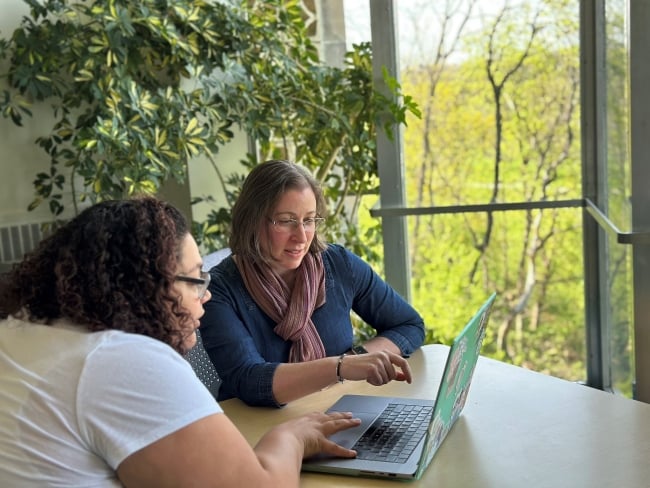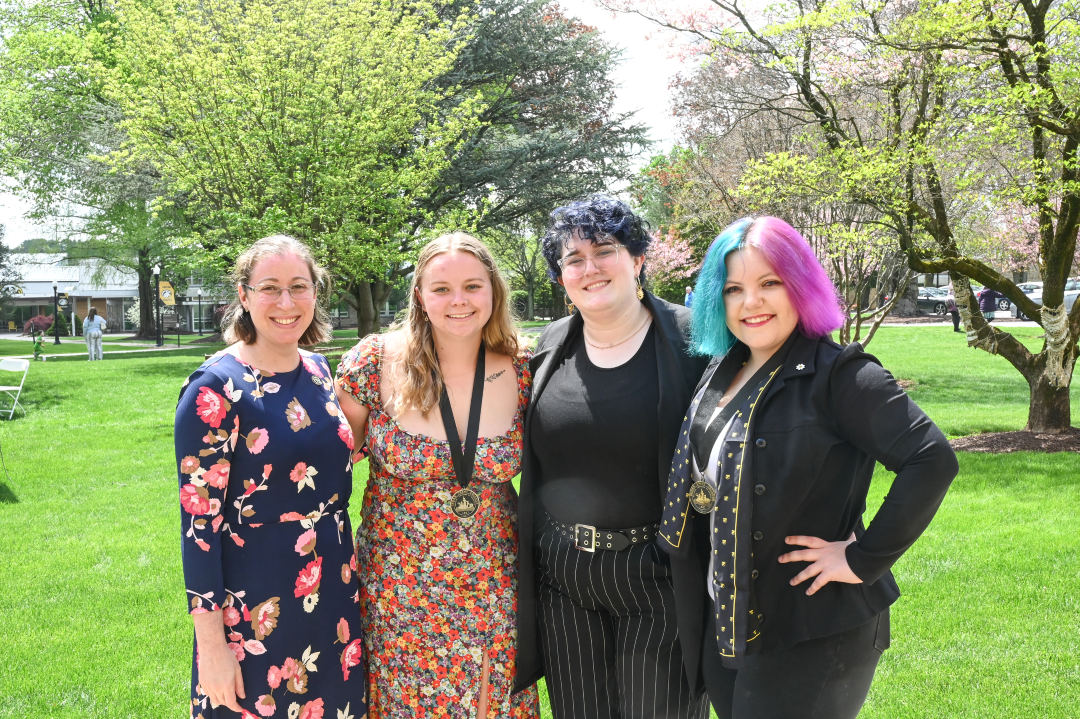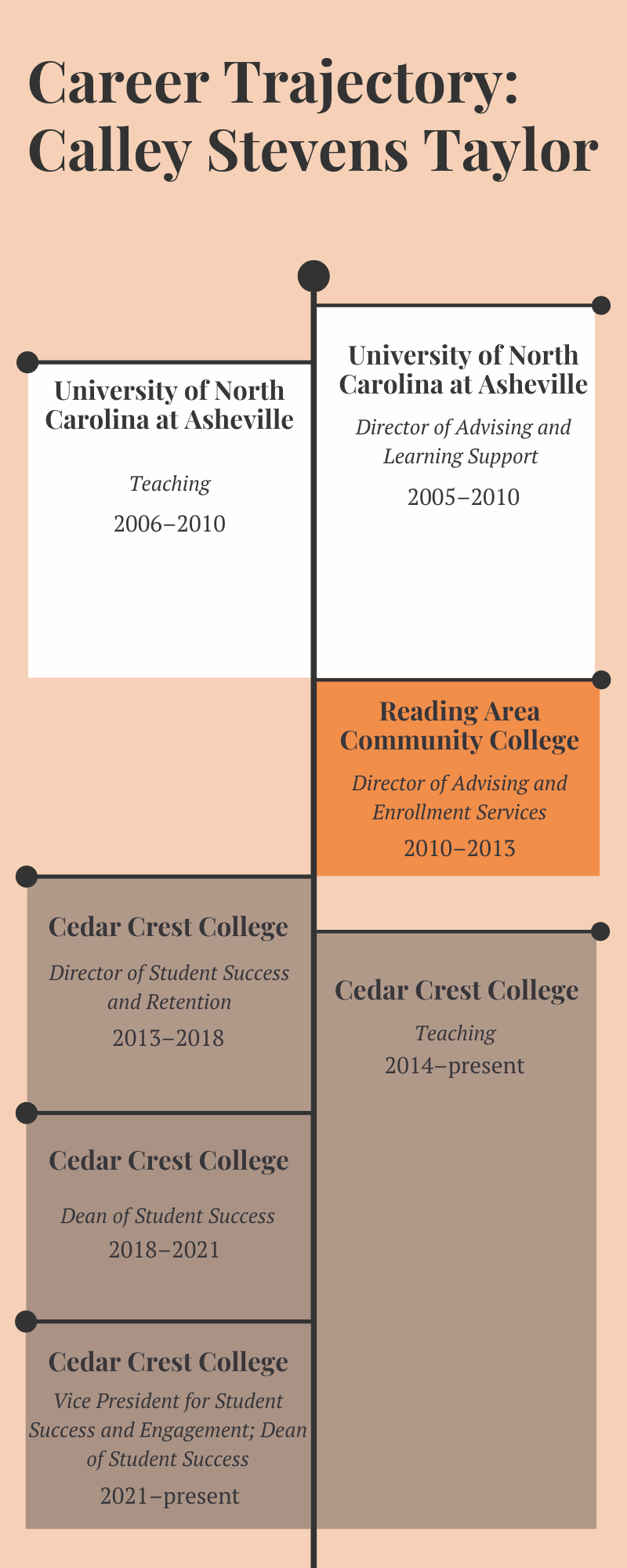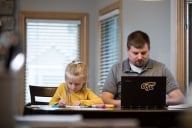You have /5 articles left.
Sign up for a free account or log in.

Calley Stevens Taylor, as vice president for student success and engagement at Cedar Crest College, prioritizes student success in the macro and micro spheres of the institution.
Alicia Shussett
Since her very first role as a professional in higher education, Calley Stevens Taylor has valued access and support for students, balancing how institutions can accommodate and provide for students in meaningful ways to promote retention and persistence.

Paul Pastrone
Now, in her role as vice president for student success and engagement and dean of students at Cedar Crest College in Pennsylvania, Stevens Taylor prioritizes creating a culture of listening to students, collaboration and holistic support.
She spoke to Inside Higher Ed about her unique role, her philosophy for student success and her student- and staff-focused goals for the next year.
Q: What led you to Cedar Crest College and this role focused on student success?
A: I was working at a local community college. What I loved about that experience was the commitment to access to education. My previous position before that had been at a public liberal arts institution, where I had done a lot of work on retention and student success.
I wanted to experience thinking about it from an access standpoint. I specifically sought out positions in community colleges, got one in Pennsylvania and really enjoyed being able to think about what it really means to expand access to education, particularly for minoritized groups. I enjoyed that work. I love the diversity of the community college experience, and I love the commitment to access. But what, frankly, I was missing in that was the companion focus on retention and student success at that particular institution.
So I started looking for opportunities that would allow me to think a little bit about both. The opportunity at Cedar Crest fell into my lap, [and] I had the opportunity to come and interview. What I love about the work that I’ve been able to do here—and almost 10 years that I’ve been here—is through our mission as a women’s institution, through our commitment to first-generation and low-income students and adult learners. I get to support a lot of that access work that I loved doing at the community college and, simultaneously, help lead efforts to make sure that those students can be successful. Getting to be a part of their whole arc is what attracted me to this position in the first place and what has kept me here.
Q: Your role combines both academic and student affairs. How does that look logistically, and how are you unifying two, typically separate, departments to make a new one?
A: It was not an easy process.
I was dean of student success under academic affairs, reporting up to the provost. As a part of some institutional change—and also some efforts to really reset how we were doing things after the bulk of the pandemic—we made the decision to take everything that I was responsible for in academic affairs—like academic advising, tutoring, disability services, first-year experience, international student services—and combine them with what was then a more traditional student affairs division: student activities, career planning, housing and residence life, etc.
That, honestly, has been a year-and-a-half-long process. We had to think about what that meant for us as a team in a different way. I had to think about the way that I wanted to structure the organization of a division in a way that would ensure that some of the gaps that had existed before were, by design, closed.
For example, one of the things we had been talking about for a long time was the disconnect between career planning and our community engagement office, because they work in a lot of the same circles, but from different perspectives. So as a part of this reorganization, we combined that into one office. We spent a lot of time team building.
One of the things that we all did together in the first couple of months was crucial conversations training, which I think was really helpful. That was a 10-hour in-person training that I asked everybody to participate in so that we could all come together with a common approach to how we were going to navigate which were going to be some emotional and difficult conversations—about professional identity, where you think you fit in the institution, what your sort of alliances or allegiances are—because for some people that was really deeply embedded.
We then spent a couple of months working on things like our purpose statement. Out of that will come our mission and vision statement. We’ve created a set of values this semester that we have all committed to for the next year. We have some work that we’re going to do over the next year to talk about how we’re going to live those values as a team.
We feel really strongly … that if we want students to have an integrative experience that doesn’t feel disconnected, we can’t be disconnected either. It’s ongoing, but it’s been fun.

Tom Amico
Q: What is student success to you?
A: I would say, in a very simplistic way, student success means that we have the structures, the people and the programs needed to meet students where they are and help them reach their goals. When we have done that, I think we have achieved student success.
What that means for each individual student, however, is far more complex than any one metric or two or three metrics can probably measure, so the way that I approach student success is to really try to think in a way that allows me to balance both the micro and the macro. Thinking about policies, programs, cultural factors, resource decisions, all of those big macro decisions that I have to make as a vice president, but also simultaneously about what those are going to mean to an individual student navigating the college experience.
To me, to be successful in student success, you have to be able to do both of those things.
The other way that I try to approach it [is] I describe it as flipping the math problem. You can say, two plus two equals four, or four equals two plus two. In higher ed, we’re very used to saying … you hire the right faculty, you teach the right classes, you have the right advisers, you have the right tutoring, you add all those things together at the end, you have a successful student. That means that we did our jobs, we were successful, when a student is successful.
I try to change that and to say, “Students are successful when we do all of that.” To put them at the beginning of the conversation, as the point of the equation, not the outcome of the equation.

Q: What challenges are you seeing at Cedar Crest College regarding student success that you’re looking to prioritize?
A: We’re certainly still seeing all of the same challenges that everybody is seeing: the mounting mental health concerns. I’m presenting to our Board of Trustees about that in a couple of weeks. What I’m going to be really careful to talk with them about is the fact that that did not start in COVID. Those are challenges that were mounting for years before, and certainly our students struggle with that.
The mental health system in the Lehigh Valley is incredibly overtaxed; we have a lot of first-generation students, we have a lot of low-income students, we have a lot of adult students. Financial concerns are often first and foremost for many of our students and their families.
The biggest challenge that weighs on me when I think about how to address all of that is how much of that is totally dependent on issues in the community, resources coming from the state, decisions made in D.C. that I can’t change on an individual student’s [basis]. If a student isn’t eligible for the next level of Pell, there’s nothing I can do about that, even though I know how much they need it. Trying to find these ways that we can lean on community partners, that we can lean on alumnae, that we can lean on our donors, to advancement to help close some of these gaps is something that we’ve been pretty successful in. But there’s so much more need out there.
Q: What were your goals in your first year and what are your goals for the upcoming academic year?
A: My goals have been, to some extent, functional: realign job descriptions, set up an organizational chart that doesn’t just re-establish old criteria under a different VP. I’ve really focused on team building, and that’s, of course, the hardest thing to really put a finger on. But if somebody could observe a divisional meeting now, compared to a divisional meeting a year ago, the culture, the teamwork, the positivity and the collaboration between the folks in my division is dramatically different. That’s the feeling that I wanted to get to a year later.
Of course, I had individual goals: occupancy plans for housing and retention goals for first-year students and all of that, but I was looking for the community that we lost during the pandemic to be reinvented among my division, and I feel really confident in saying that we’ve gotten there.
Going into the next year, we’re starting a new strategic plan, so I’m excited for some of the upcoming student success–related initiatives in that. We’re looking at everything from expanding our wellness programming to exploring opportunities to improve affordability and access like bundling textbooks, providing laptops to students, campus accessibility efforts for students with disabilities. There’s a whole host of things. It’s about a quarter of our strategic plan that specifically speaks to student success. I’m excited to dig into some of those new initiatives.
Seeking stories from campus leaders, faculty members and staff for our Student Success focus. Share here.








